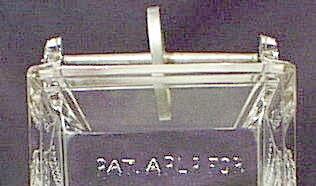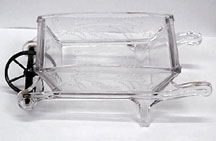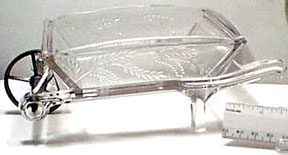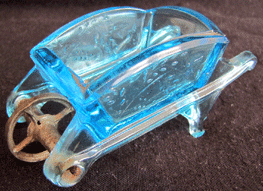| As Revi indicated in American Pressed Glass and Figure Bottles, James Dalzell patented a design for glassware in the shape of a wheelbarrow on January 3, 1882 (100). The wheelbarrow comes in two sizes and, as the patent states, |  |
 |
was intended to be used for salt, matches, or similar items. The box of the smaller-sized wheelbarrow measures 2" by 2 1/2", exclusive of the wheel and handles. The length is 4 1/4"with the wheel & handles, & the height of the wheelbarrow is 1 3/4". In the base is inscribed, |
| "PAT. APLD FOR" The measurements of
the larger size are 4 1/4" by 5 3/8" (8" with the wheel
and handle). The height is 2 3/4". Some contain the patent applied for statement in the base, while others show rough-cut boards, similar to those seen on the Wooden Pail pattern or in the base of Log Cabin pieces. On the latter type, the patent applied for statement is printed on |
| the back of the box. Although the patent indicates that the wheel may be made of glass, I have only seen them made of pewter. The wheelbarrows may be found in clear, frosted, and amber. (see addendum to come) These wheelbarrows have long been associated with the Barley pattern. It would appear that Alice Hulett Metz (85) was |
 |
| the first author to make this connection, as neither Ruth Webb Lee (347-48) nor Minnie Watson Kamm (33) mention a wheelbarrow in relation to the Barley pattern. Subsequent authors followed suit and listed them under the Barley pattern. I believe these wheelbarrows are actually part of the Horseshoe pattern, aka Good Luck or Prayer Rug pattern. The most compelling evidence for this is seen in the design. A close up view of the pattern on the wheelbarrow reveals that it consists of a single branch which contains two different fern-like protrusions and ends with a five-petal flower that is preceded by two sets of leaves. One of the fern-like protrusions is made of stippled ellipses along a stem. The stem of the other protrusion has circles that are attached by smaller stems. On the Barley pattern, instead of a single branch, this pattern has a two thinner vines. While this pattern also has two distinct fern-like leaves, they are unlike those seen on the wheelbarrow. On the Barley pattern one set of leaves is more square in shape, and the leaves on the other are made of straight |
| lines. Occasionally, there are clusters of three circles, resembling berries. No piece of Barley has five-petal flowers. On a Horseshoe water tray the shape of both kinds of leaves and the flower exactly match those seen on the wheelbarrow. It is true that neither the horseshoe nor the prayer rug |  |
| are found on the wheelbarrow; however, other pieces in the pattern also lack certain of the pattern's motifs. For example, goblets, wines, creamers, spooners, celery vases, and water pitchers do not have horseshoes. The round master salts and flat sauce dishes do not contain the prayer rug. Neither the horseshoe nor the prayer rug are found on true open compotes or footed sauce dishes. Other evidence that connects the wheelbarrows to the Horseshoe pattern is the fact that James Dalzell was an officer at Adam's and Company (Revi 15). This company produced the Horseshoe pattern around 1881 (Revi 20). While I believe that the design on these wheelbarrows clearly links them to the Horseshoe pattern, I welcome further discussion on the subject, as well as copies of trade catalogs or ad reprints that definitively show the connection. |
| Works Cited: Kamm, Minnie Watson. Two Hundred Pattern Glass Pitchers. Detroit: Motschall, 1939. Lee, Ruth Webb. Early American Pressed Glass. Enlarged and Revised. Framingham Centre, MA: Author, 1931, 1933. Metz, Alice Hulett. Early American Pattern Glass. Columbus: Spencer-Walker Press, 1958. Revi, Albert Christian. American Pressed Glass and Figure Bottles. New York: Thomas Nelson and Sons, 1964. |
 |
| Our good friend Dave Peterson has graciously shared photos of his new-found and heretofore undescribed vaseline & amber colored Carts! This leads to the hope that it will be found in blue as well. |
 |
Comes now another good friend, Gene Serbus, and takes us to the blue Cart! He found it on ebay in a 'lot' of blue glass. Thanks for sharing, Gene! |
We're sharing a couple of them below, again compliments of Dave Peterson.
 |
| Dave also sent us photos of an amber KING & CO. slab soap dish next to the vaseline King & Co. Bracket soap dish. On the left is the illustration out of Bob Sanford's book on victorian novelties and Dave's actual pieces on the right. Dave (Mr. Vaseline Glass) is a specialist in Vaseline glass and Editor and Board of Trustees member of Vaseline Glass Collectors, Inc. |
 |
 |
 |